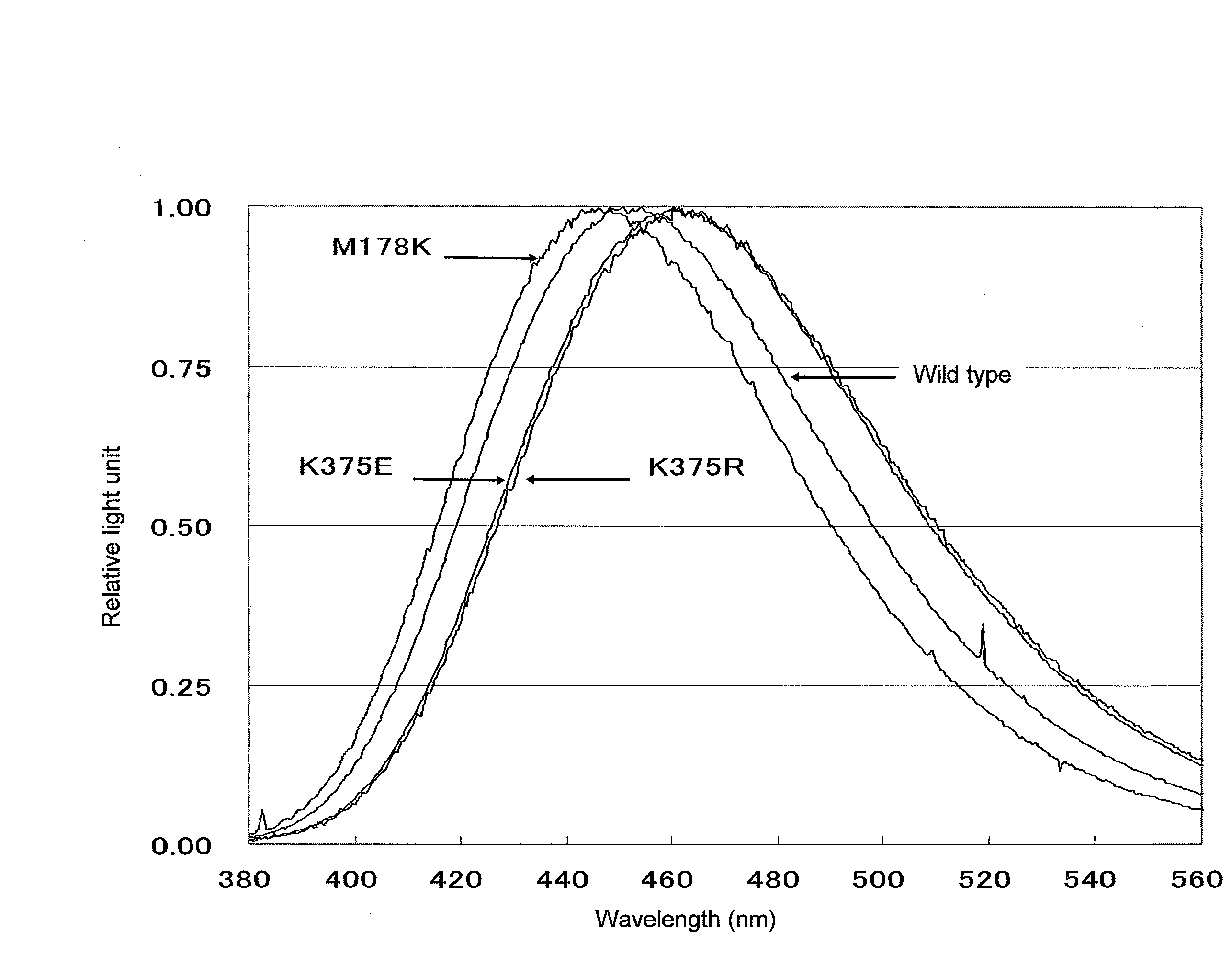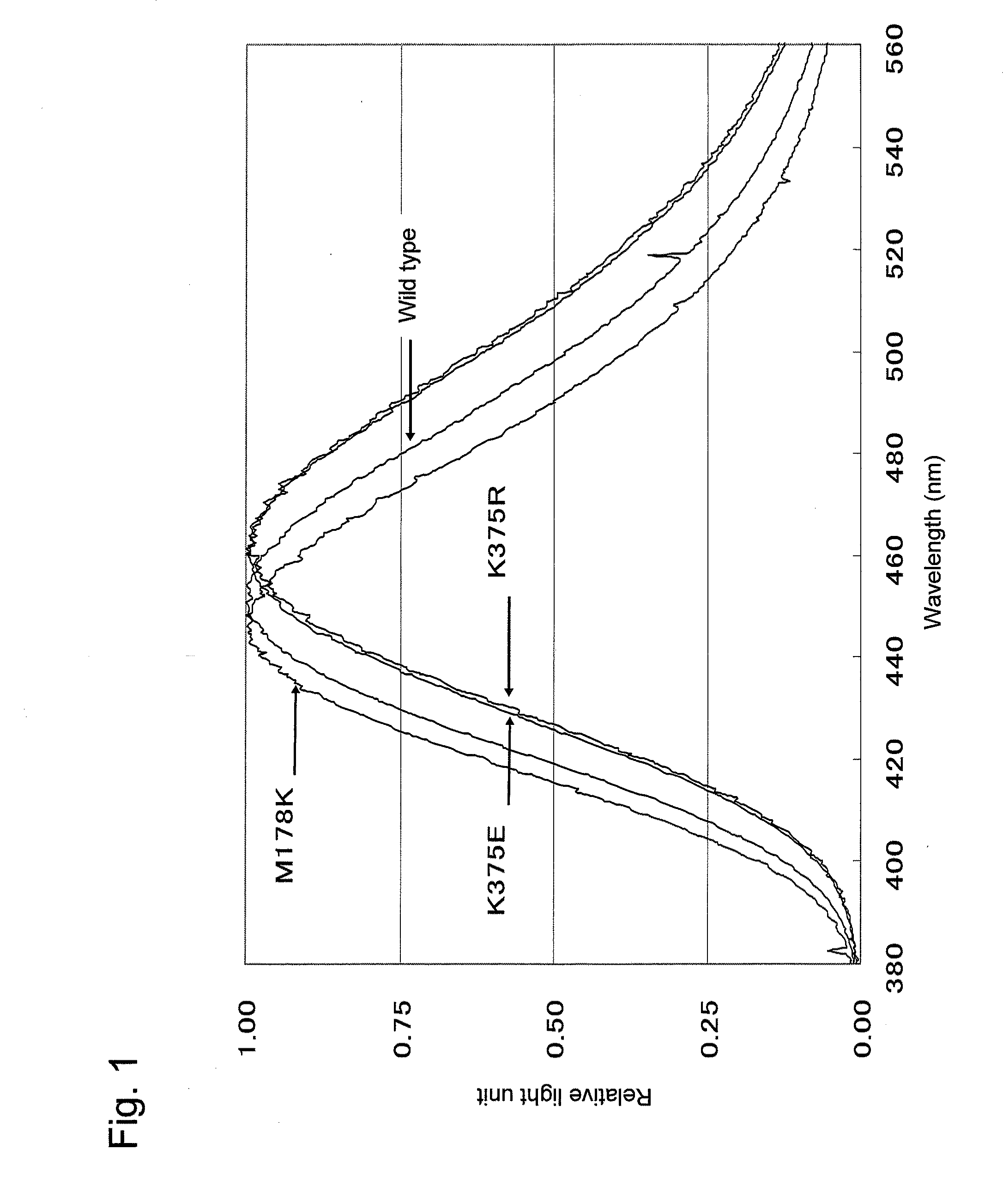Mutant luciferase
- Summary
- Abstract
- Description
- Claims
- Application Information
AI Technical Summary
Benefits of technology
Problems solved by technology
Method used
Image
Examples
example 1
Secretion and Expression of CLuc in Saccharomyces cerevisiae
[0198]The plasmid pCLuRA-TDH3 disclosed in the pamphlet of International Publication No. 2006 / 132350 was used as an expression vector for secretion and expression of CLuc in Saccharomyces cerevisiae.
[0199]The plasmid pCLuRA-TDH3 contained a gene (hereinafter, referred to as “αCLuc gene”) encoding a fusion protein (hereinafter, referred to as “α CLuc”) of a secretory signal peptide (amino acid sequence: SEQ ID NO: 3) of a factor of budding yeast with a CLuc mature protein (the amino acid sequence resulting when an amino acid sequence ranging from positions 1 to 18 had been removed from the amino acid sequence of CLuc shown in SEQ ID NO: 2). The amino acid sequence shown in SEQ ID NO: 6 was the amino sequence of αCLuc. The fusion protein of CLuc with the secretory signal peptide derived from a factor was prepared, so that CLuc was secreted outside the microorganisms.
[0200]Furthermore, in the plasmid pCLuRA-TDH3, a promoter ...
example 2
Isolation of Mutant Luciferase Via Introduction of Random Mutation
2-1. Construction of Mutant CLuc Gene Library (N-Region Mutant Library)
[0205]A random point mutation was introduced into the αCLuc coding region of the plasmid pCLuRA-TDH3 by error prone PCR.
[0206]The subject region for introduction of the mutation was the first half portion of the αCLuc coding region (in the nucleotide sequence shown in SEQ ID NO: 7, the nucleotide sequence ranging from positions 900 to 1813; hereinafter, referred to as “N region”). The reason for limiting the range is that amplification of a long region is frequently difficult in error prone PCR. Moreover, the reason for not using as a subject region the nucleotide sequence ranging from positions 701 to 899 of the nucleotide sequence shown in SEQ ID NO: 7 is that this portion is a region encoding most of the secretory signal peptide of a factor.
[0207]The following oligo DNA primers were used in error prone PCR of the N region.
mut-CLuc-F:ATACTACTATTG...
example 3
Construction of T167 Saturation Mutant Library and Screening for Mutant CLuc
[0260]As a result of screening described in Example 2, a T167I mutant (a clone having T167I mutant CLuc in which threonine at position 167 of the amino acid sequence shown in SEQ ID NO: 2 had been substituted with isoleucine; corresponding to a transformant having the 3rd mutant luciferase(s)) was obtained. A plasmid retained by the clone is referred to as “pCLuRA-TDH3[T167I].” The emission spectral peak of the mutant CLuc secreted from the T167I mutant was 458 nm as measured by the method described in the section 2-5 in Example 2, indicating a shift to the longer wavelength side of 4 nm compared with that of wild-type CLuc.
[0261]Accordingly, a mutant library (hereinafter, referred to as the “T167 saturation mutant library”) was constructed as follows, in which amino acid at position 167 of the amino acid sequence shown in SEQ ID NO: 2 was substituted with any one of the other amino acids. Then obtainment of...
PUM
| Property | Measurement | Unit |
|---|---|---|
| Nanoscale particle size | aaaaa | aaaaa |
| Nanoscale particle size | aaaaa | aaaaa |
| Nanoscale particle size | aaaaa | aaaaa |
Abstract
Description
Claims
Application Information
 Login to View More
Login to View More - R&D
- Intellectual Property
- Life Sciences
- Materials
- Tech Scout
- Unparalleled Data Quality
- Higher Quality Content
- 60% Fewer Hallucinations
Browse by: Latest US Patents, China's latest patents, Technical Efficacy Thesaurus, Application Domain, Technology Topic, Popular Technical Reports.
© 2025 PatSnap. All rights reserved.Legal|Privacy policy|Modern Slavery Act Transparency Statement|Sitemap|About US| Contact US: help@patsnap.com


